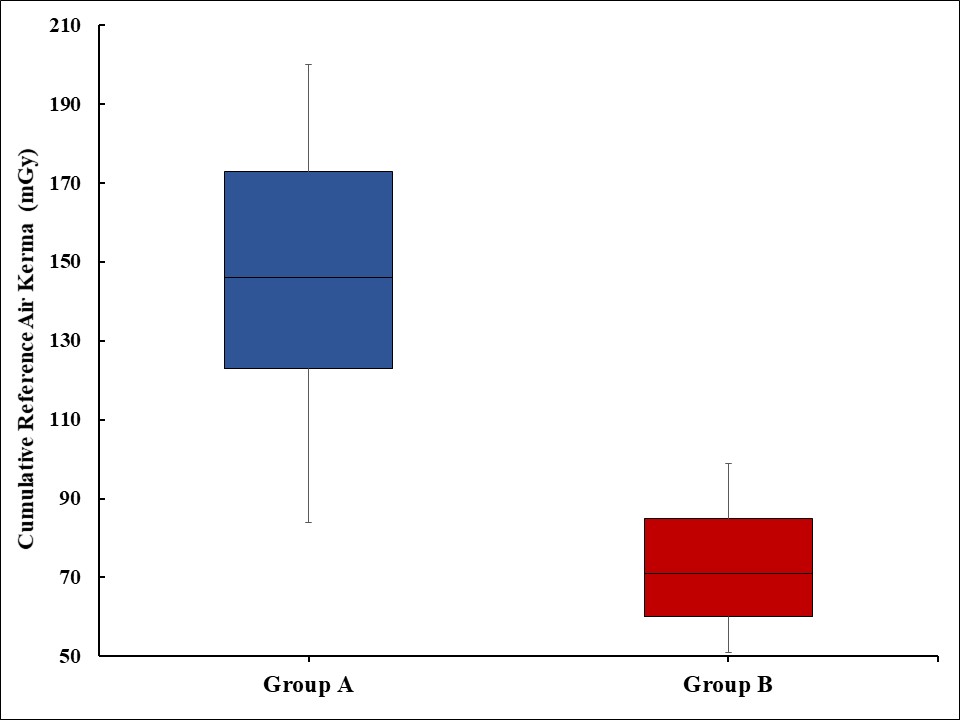New Imaging Technology System Reduces Patient Radiation Dose During Peripheral Arterial Endovascular Interventions
Alejandro Pizano, MD, Ali Khurram, BS, Khalil Chamseddin, MD, Carlos Timaran, MD, Carlos Timaran, MD, Shadman Baig, MD, Michael Shih, MD, Jeffrey Guild, PhD, Melissa L. Kirkwood, MD.
University of Texas Southwestern Medical Center, Dallas, TX, USA.
 OBJECTIVES: Radiation exposure and imaging quality are among the main concerns in endovascular procedures. The CLEAR-MAX imaging technology system (VD11-PURE platform, Siemens Healthineers, Erlangen, Germany) claims to lower radiation dose while improving image quality. This study evaluated whether the radiation dose during peripheral arterial endovascular procedures decreases after implementing this system. METHODS: Patient characteristics (age, gender, body mass index), procedure type (diagnostic, balloon angioplasty, atherectomy, and stenting), location (aortoiliac, superficial femoral artery, and tibial artery), reference air kerma (RAK), kerma area product (KAP), and fluoroscopy time (FT) were recorded during peripheral artery interventions performed 1-year before (group A) and 1-year after (group B) the system upgrade. Procedures were performed in an Artis-Q.zen hybrid room (Siemens Healthineers) with the same providers. A linear model was used to estimate the average difference between groups adjusted by procedure type, age, gender, and BMI. Additionally, to control for variations in case complexity, groups were matched by age, gender, BMI, location, and intervention type. A propensity score matching, and a paired t-test were used to compare groups for the KAP, RAK, and FT stratified by single intervention procedures. RESULTS: 487 endovascular procedures were collected; 209 in group A and 278 in group B. 111 single procedures from each group were matched (1:1) with a mean age of 61±8 years and a BMI of 26.5±4. Median (IQR) KAP, RAK, and FT of group A were 28.8 Gycm2 (24-34), 146 mGy (123-173), and 12 min (10-14), respectively. Median KAP, RAK, and FT of group B was 18.3 Gycm2 (16-22), 71.2 mGy (60-85), and 10.4 min (9-12). KAP, RAK, and FT decreased by 24% (p=.05), 41% (p=.01), and 22% (p=.02) respectively. Stratified by one procedure, KAP and RAK decreased by 36% (p=.02) and 51% (p=.01). The FT decrease of 13% was not significantly different. CONCLUSIONS: The CLEAR-MAX system reduces patient radiation dose up to 51% during endovascular peripheral interventions. The statistically similar fluoroscopy times for matched single intervention procedures before and after the upgrade indicate consistent case complexity and surgeon practice. This platform appears to be an effective system in lowering the radiation dose while maintaining image quality.
OBJECTIVES: Radiation exposure and imaging quality are among the main concerns in endovascular procedures. The CLEAR-MAX imaging technology system (VD11-PURE platform, Siemens Healthineers, Erlangen, Germany) claims to lower radiation dose while improving image quality. This study evaluated whether the radiation dose during peripheral arterial endovascular procedures decreases after implementing this system. METHODS: Patient characteristics (age, gender, body mass index), procedure type (diagnostic, balloon angioplasty, atherectomy, and stenting), location (aortoiliac, superficial femoral artery, and tibial artery), reference air kerma (RAK), kerma area product (KAP), and fluoroscopy time (FT) were recorded during peripheral artery interventions performed 1-year before (group A) and 1-year after (group B) the system upgrade. Procedures were performed in an Artis-Q.zen hybrid room (Siemens Healthineers) with the same providers. A linear model was used to estimate the average difference between groups adjusted by procedure type, age, gender, and BMI. Additionally, to control for variations in case complexity, groups were matched by age, gender, BMI, location, and intervention type. A propensity score matching, and a paired t-test were used to compare groups for the KAP, RAK, and FT stratified by single intervention procedures. RESULTS: 487 endovascular procedures were collected; 209 in group A and 278 in group B. 111 single procedures from each group were matched (1:1) with a mean age of 61±8 years and a BMI of 26.5±4. Median (IQR) KAP, RAK, and FT of group A were 28.8 Gycm2 (24-34), 146 mGy (123-173), and 12 min (10-14), respectively. Median KAP, RAK, and FT of group B was 18.3 Gycm2 (16-22), 71.2 mGy (60-85), and 10.4 min (9-12). KAP, RAK, and FT decreased by 24% (p=.05), 41% (p=.01), and 22% (p=.02) respectively. Stratified by one procedure, KAP and RAK decreased by 36% (p=.02) and 51% (p=.01). The FT decrease of 13% was not significantly different. CONCLUSIONS: The CLEAR-MAX system reduces patient radiation dose up to 51% during endovascular peripheral interventions. The statistically similar fluoroscopy times for matched single intervention procedures before and after the upgrade indicate consistent case complexity and surgeon practice. This platform appears to be an effective system in lowering the radiation dose while maintaining image quality.
Back to 2022 ePosters
